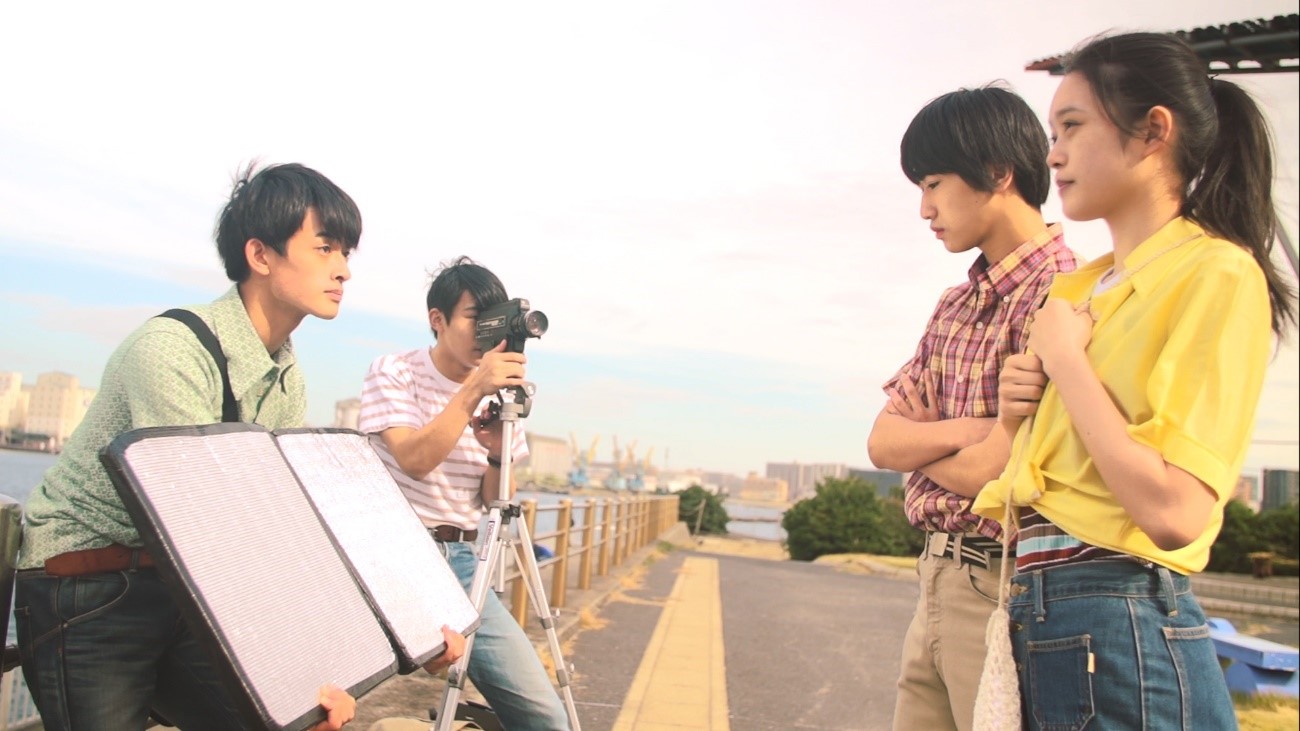Introduction
For his latest project, director Kazuya Konaka delves deep into his adolescent years and his youthful obsession with making 8mm films to deliver a narrative that celebrates the act of creating a filmic experience with little to no budget. Yet, can Konaka’s personal narrative, which features two reproductions of his own youthful directorial work, also charm and impress the spectator?
Review
In June 1978, Star Wars premiered to great success in Japan. Hiroshi Kurita (Yuu Umemura), a high-schooler, inspired by this incredible space opera, dreams of making his own sci-fi movie shots. With the help of Sasaki (Ryuta Kuwayama), he tries and eventually successfully makes a shot of a spaceship flying through space. Upon seeing their shot, the university student (Yusuke Sato), who works at the local photography shop, ask to know more about the story. Yet, neither Hiroshi nor Sasaki has thought of creating a full-blown sci-fi narrative.
Not much later, during a class-meeting to decide what to do for their last culture festival, Hiroshi raises his hand and proposes to make a film. Yet, before agreeing with their proposal, their teacher (Takuji Kawakubo) demands that they make a narrative outline of the film and decide on the cast. Yet, convincing Natsumi Yamashita (Akari Takaishi), the girl he loves, is easier said than done.
With so many Japanese movies that explore film-making in some way (e.g. Why Don’t You Play In Hell (2023), One Cut Of The Dead (2017), Uzumasa Limelight (2014), Lowlife Love (2015), Red Post on Escher Street (2020), … etc.), it is difficult to imagine that the theme can be approached in a fresh way. Yet, by focusing on the Single8 camera and filmmaking in analog times, Kazuya Konaka successfully add an original contribution to the long list of films celebrating filmmaking.
In the era ruled by computer-generated effects and visual excess, Single8 offers the spectator a refreshing insight in the creative solutions filmmakers has to use to create, with limited budget, their own special effects, their tokusatsu shots (e.g. composite shots, adding of titles and music, … etc.) and the physicality that marked the stages of finalizing a film (e.g. editing, sound-recording, …. etc.). By focusing on this physicality of the filmmaking process – a physicality that has largely disappeared in contemporary Hollywood cinema, Konaka successfully stages that the act of creation, the materialization of one’s idea or fantasy on film, delivers joy and pleasure.
To put it differently, what makes Single8 so moving and so satisfying is the fact that it succeeds in singling out the very dynamic the drives author and indie filmmakers. While it is evident that passion fuels the creative process and that such passion finds its reinforcement by seeing one’s vision slowly come to life, Single8 emphasizes the ‘socialized’ aspect of such passion. What ultimately drives the filmic project and supports the passion of the director is the very community that comes into being by transforming his individual passion into one that gives rise to a sense of togetherness.
The composition of Single8 has a dynamic feel due to the combined use of camera movement and shaky framing (Cine-note 1). The shakiness, moreover, adds a subtle documentary feel to the fictional narrative and enables, whenever it is necessary, the amplification of the protagonists’ emotions. The documentary-tremble, furthermore, allows the emotions expressed by the cast and the interpersonal conflicts feel more genuine and more able to engage and touch the spectator.
Of course, such decorative element would miss its effect were it not for the great performances by the cast. Yuu Umemura, in particular, infuses a lot of charm into the youthful enthusiasm of his character and might, as a result, even succeed to inspire young people to try their hand a creating short-movies. Akari Takaishi, on the other hand, ‘possesses’ the screen with her charming and bashful presence. Due to her nuanced performance, the spectator can easily feel the effect her character has on Hiroshi.
Yet, what truly elevates the narrative and pulls the spectator into our protagonists’ attempt to make a sci-fi narrative is the chemistry between the cast-members. The genuine feel of the emotions that arise between them by exchanging signifiers and acts truly allows the joy of creation to touch the spectator. Moreover, this on-screen chemistry ensures that the element of romance that lingers within the narrative does not feel forced – it is a genuine part of Hiroshi’s adolescence.
The musical accompaniment is mainly utilized to brighten up sequences that stage the joy of making models and the creative ways our protagonists discover to overcome obstacles (e.g. convince Natsumi to be the heroine) and challenges (e.g. coming up with a story). By subtly echoing the enthusiasm of our youths, these musical pieces allow the spectator to indirectly partake in the excitement of creation.
With Single8, Kazuya Konaka does not merely deliver a fictional account of a period in his adolescence, but offers the spectator a heartwarming invitation to re-find, within oneself, one’s (nearly extinguished) passion for creation. Yet, what allows Konaka’s narrative to have such an effect on the spectator is not simply the pleasantly structured narrative, but the performances that bring the passion that drives our students to finish their low-budget movie genuinely to life.
Notes
Cine-note 1: While there are more static moments in the narrative as well, they do clash with the general documentary feel of the narrative.





2 Comments Add yours